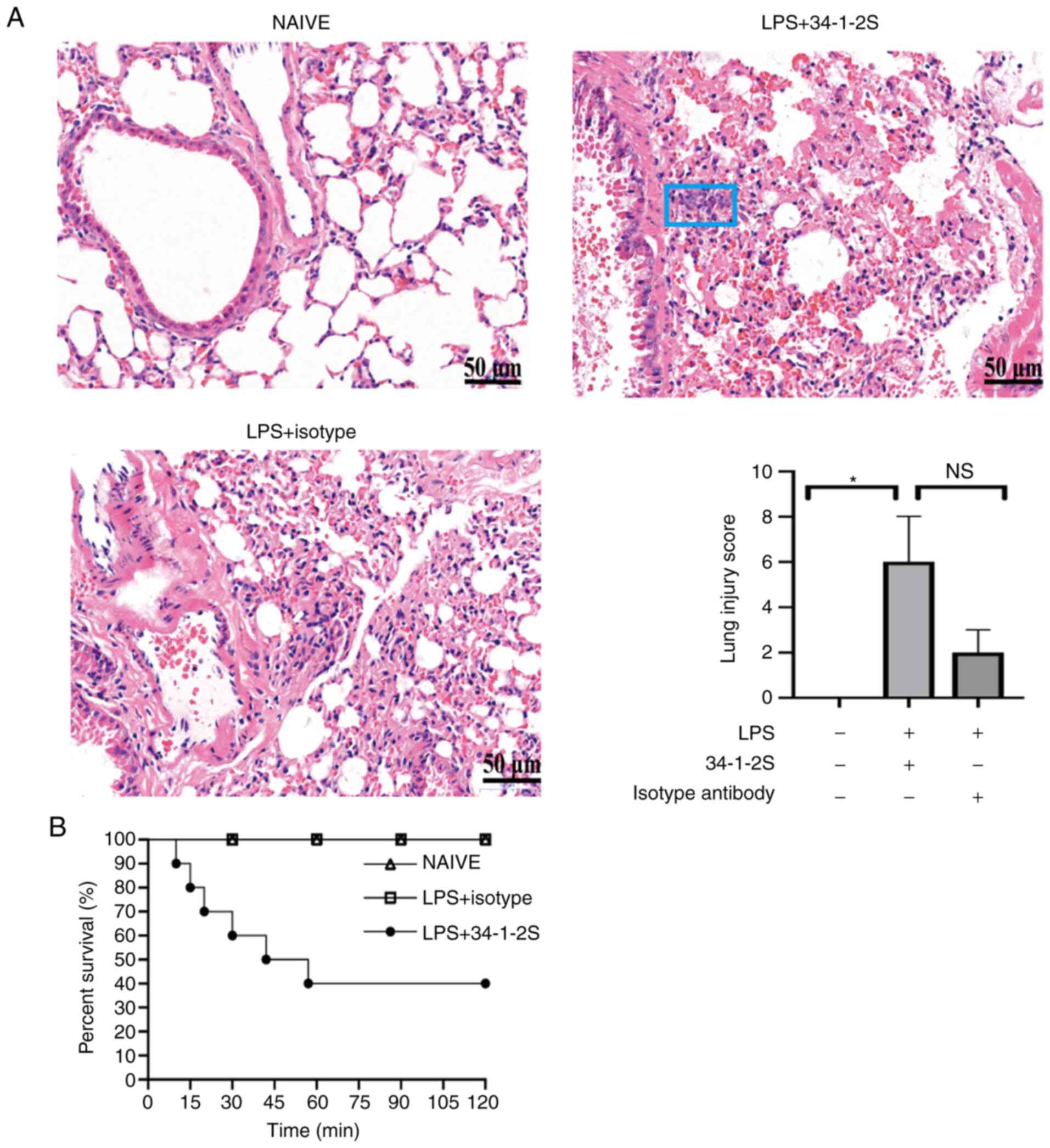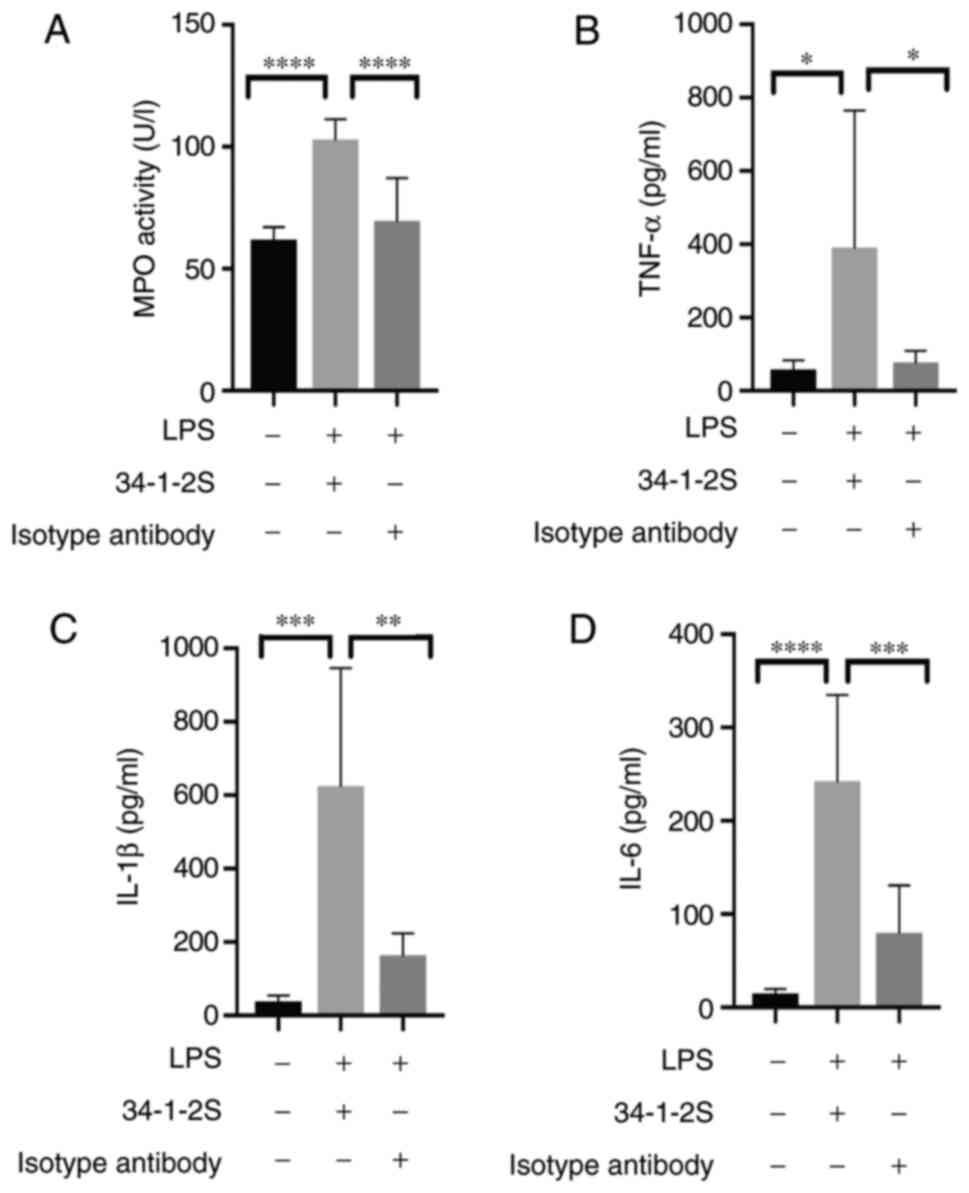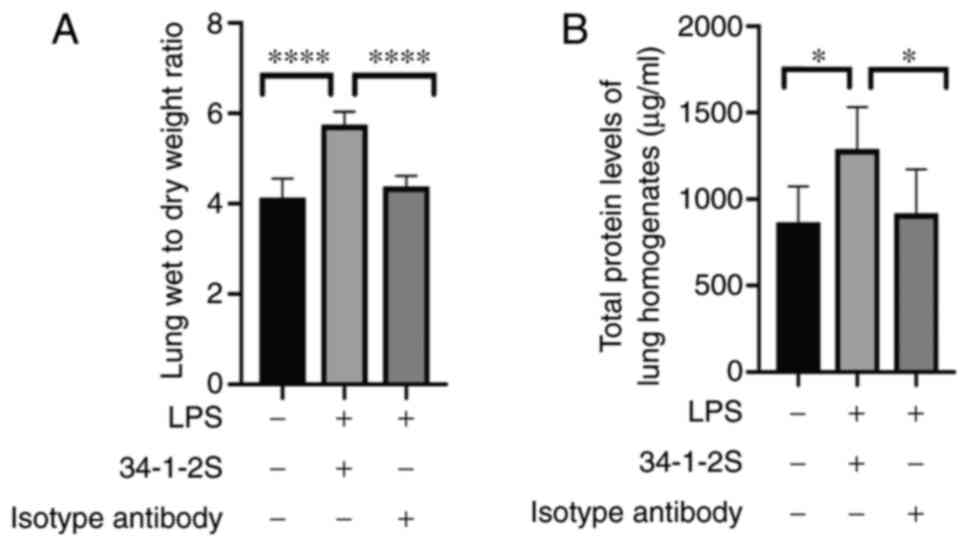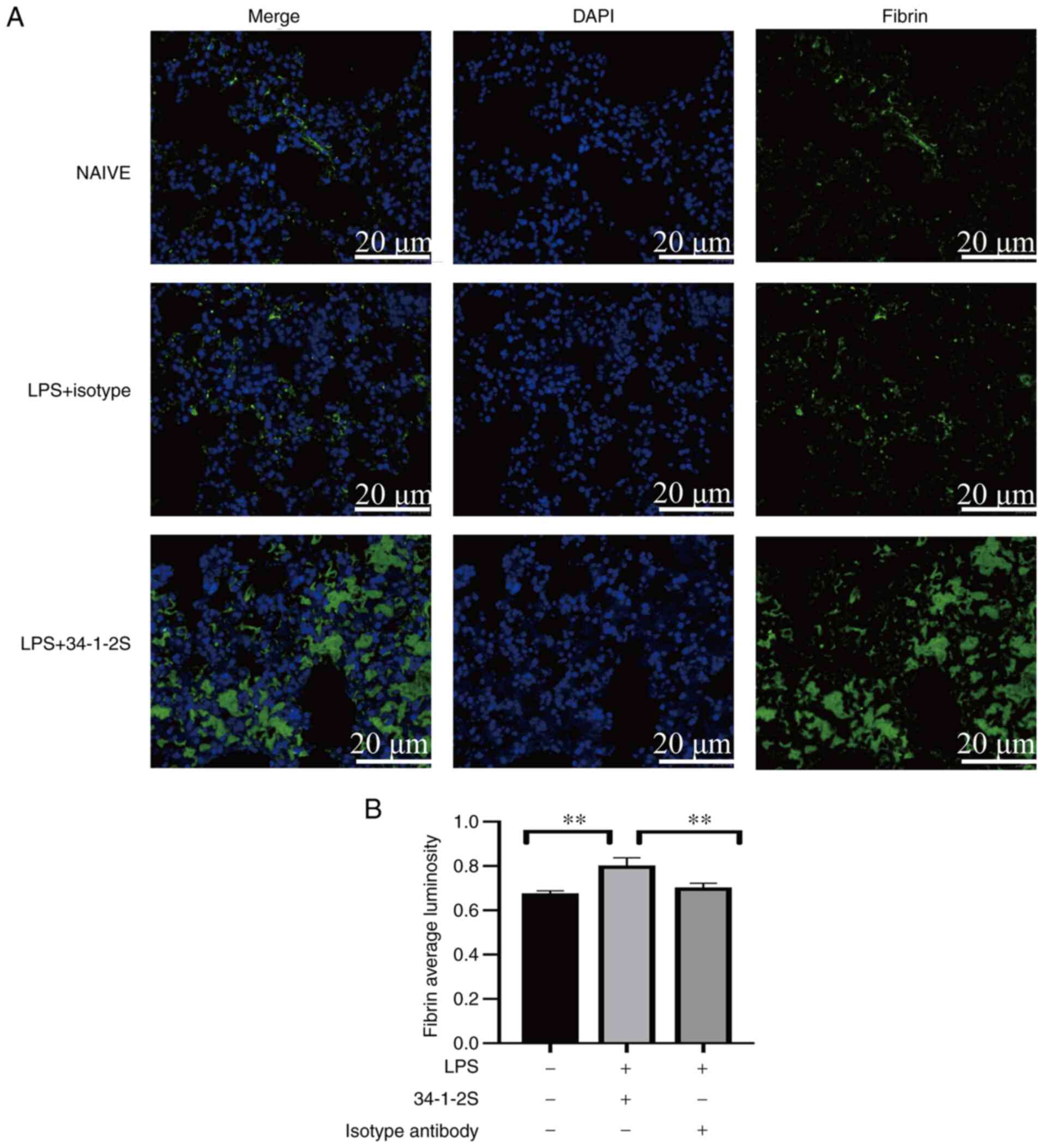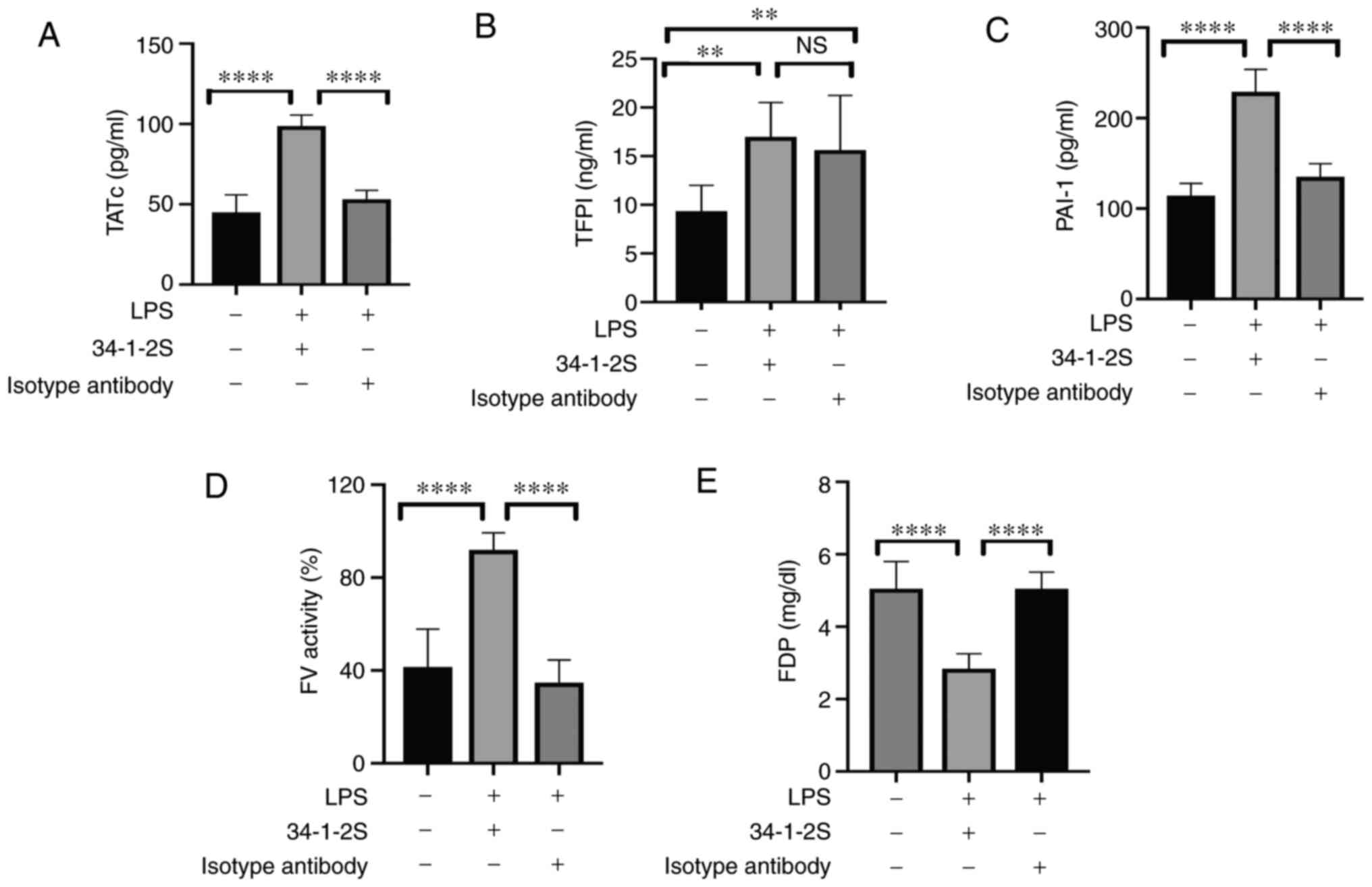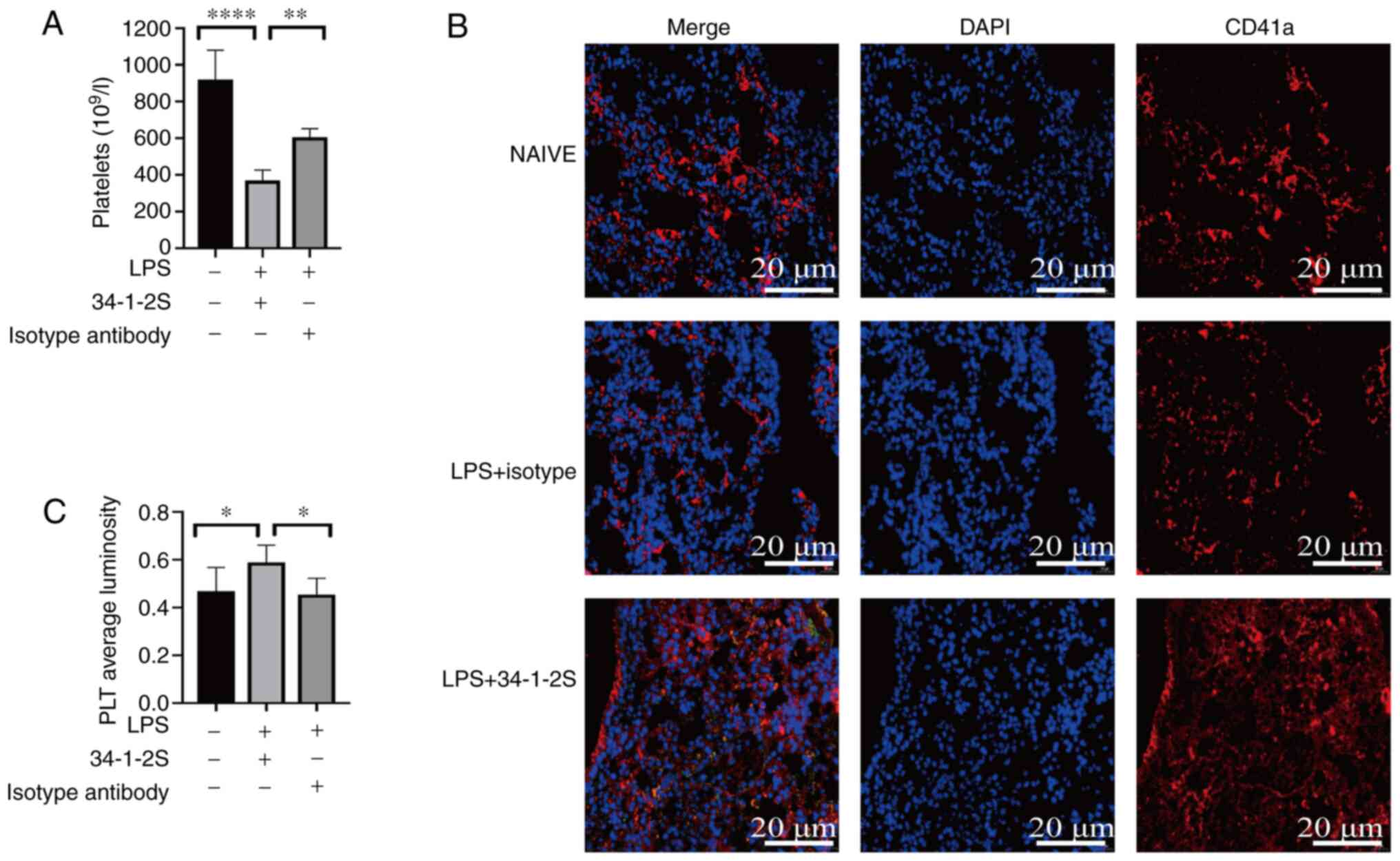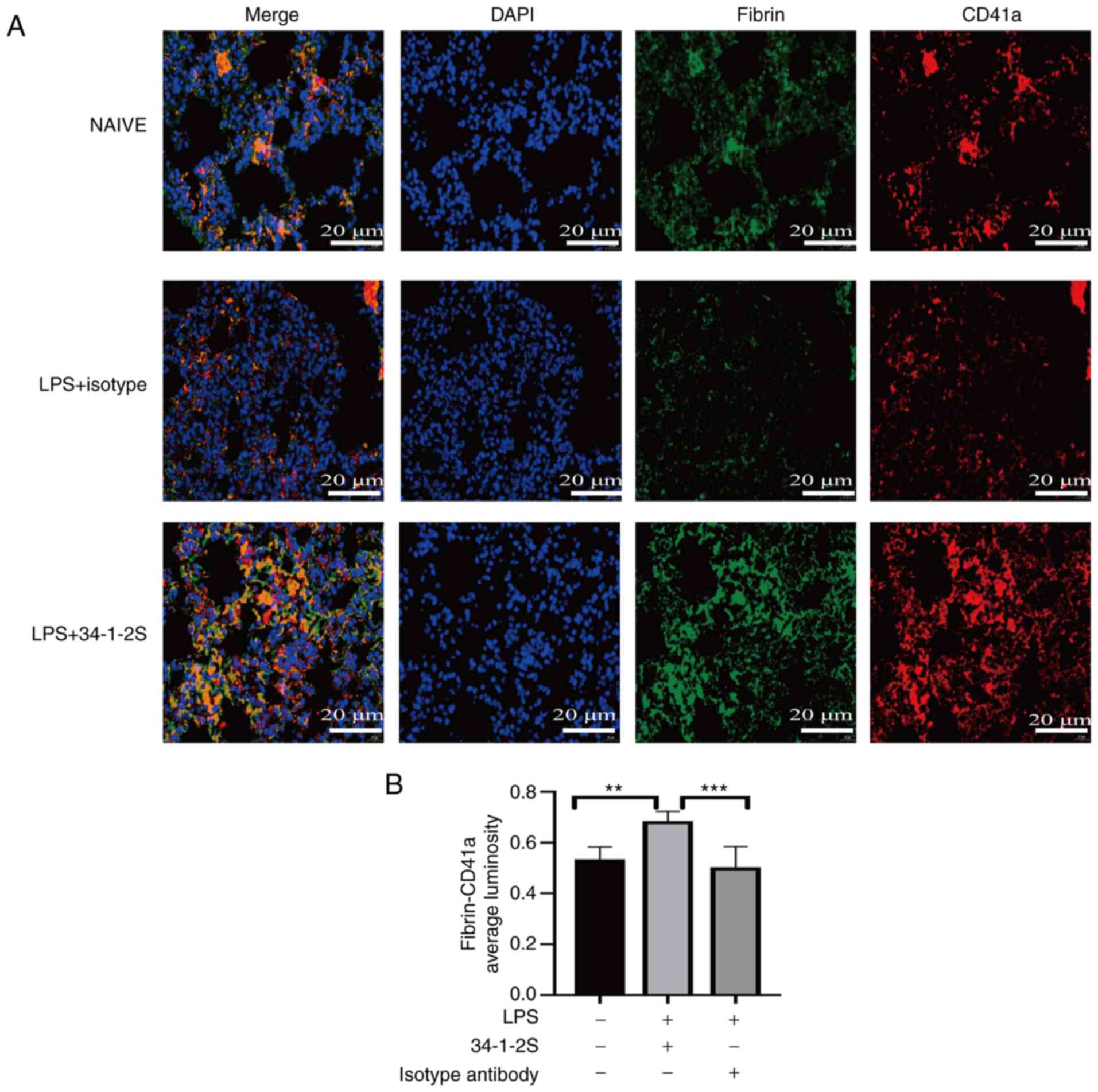|
1
|
Semple JW, Rebetz J and Kapur R:
Transfusion-associated circulatory overload and transfusion-related
acute lung injury. Blood. 133:1840–1853. 2019. View Article : Google Scholar : PubMed/NCBI
|
|
2
|
Looney MR, Nguyen JX, Hu Y, Van Ziffle JA,
Lowell CA and Matthay MA: Platelet depletion and aspirin treatment
protect mice in a two-event model of transfusion-related acute lung
injury. J Clin Invest. 119:3450–3461. 2009.PubMed/NCBI
|
|
3
|
Hu A, Chen W, Wu S, Pan B, Zhu A, Yu X and
Huang Y: An animal model of transfusion-related acute lung injury
and the role of soluble CD40 ligand. Vox Sang. 115:303–313. 2020.
View Article : Google Scholar : PubMed/NCBI
|
|
4
|
Wang L, Wu T, Yan S, Wang Y, An J, Wu C,
Zhang Y, Ma Y, Fu Q, Wang D, et al: M1-polarized alveolar
macrophages are crucial in a mouse model of transfusion-related
acute lung injury. Transfusion. 60:303–316. 2020. View Article : Google Scholar : PubMed/NCBI
|
|
5
|
Sebag SC, Bastarache JA and Ware LB:
Therapeutic modulation of coagulation and fibrinolysis in acute
lung injury and the acute respiratory distress syndrome. Curr Pharm
Biotechnol. 12:1481–1496. 2011. View Article : Google Scholar : PubMed/NCBI
|
|
6
|
Ware LB and Matthay MA: The acute
respiratory distress syndrome. N Engl J Med. 342:1334–1349. 2000.
View Article : Google Scholar : PubMed/NCBI
|
|
7
|
De Michele S, Sun Y, Yilmaz MM, Katsyv I,
Salvatore M, Dzierba AL, Marboe CC, Brodie D, Patel NM, Garcia CK,
et al: Forty Postmortem Examinations in COVID-19 Patients. Am J
Clin Pathol. 154:748–760. 2020. View Article : Google Scholar : PubMed/NCBI
|
|
8
|
Johnson S, Shaikh SB, Muneesa F, Rashmi B
and Bhandary YP: Radiation induced apoptosis and pulmonary
fibrosis: Curcumin an effective intervention? Int J Radiat Biol.
96:709–717. 2020. View Article : Google Scholar : PubMed/NCBI
|
|
9
|
Poole LG, Massey VL, Siow DL,
Torres-Gonzáles E, Warner NL, Luyendyk JP, Ritzenthaler JD, Roman J
and Arteel GE: Plasminogen activator inhibitor-1 is critical in
alcohol-enhanced acute lung injury in mice. Am J Respir Cell Mol
Biol. 57:315–323. 2017. View Article : Google Scholar : PubMed/NCBI
|
|
10
|
Yasui H, Donahue DL, Walsh M, Castellino
FJ and Ploplis VA: Early coagulation events induce acute lung
injury in a rat model of blunt traumatic brain injury. Am J Physiol
Lung Cell Mol Physiol. 311:L74–L86. 2016. View Article : Google Scholar : PubMed/NCBI
|
|
11
|
Vadász I, Morty RE, Olschewski A,
Königshoff M, Kohstall MG, Ghofrani HA, Grimminger F and Seeger W:
Thrombin impairs alveolar fluid clearance by promoting endocytosis
of Na+,K+-ATPase. Am J Respir Cell Mol Biol.
33:343–354. 2005. View Article : Google Scholar
|
|
12
|
Mitchell WB: Thromboinflammation in
COVID-19 acute lung injury. Paediatr Respir Rev. 35:20–24.
2020.PubMed/NCBI
|
|
13
|
Tuinman PR, Schultz MJ and Juffermans NP:
Coagulopathy as a therapeutic target for TRALI: Rationale and
possible sites of action. Curr Pharm Des. 18:3267–3272. 2012.
View Article : Google Scholar : PubMed/NCBI
|
|
14
|
Idell S, James KK, Levin EG, Schwartz BS,
Manchanda N, Maunder RJ, Martin TR, McLarty J and Fair DS: Local
abnormalities in coagulation and fibrinolytic pathways predispose
to alveolar fibrin deposition in the adult respiratory distress
syndrome. J Clin Invest. 84:695–705. 1989. View Article : Google Scholar : PubMed/NCBI
|
|
15
|
Tian LQ, Guo ZH, Meng WZ, Li L, Zhang Y,
Yin XH, Lai F, Li YY, Feng LL, Shen FF, et al: The abnormalities of
coagulation and fibrinolysis in acute lung injury caused by gas
explosion. Kaohsiung J Med Sci. 36:929–936. 2020. View Article : Google Scholar : PubMed/NCBI
|
|
16
|
Khalaj K, Figueira RL, Antounians L,
Lauriti G and Zani A: Systematic review of extracellular
vesicle-based treatments for lung injury: Are EVs a potential
therapy for COVID-19? J Extracell Vesicles. 9:17953652020.
View Article : Google Scholar : PubMed/NCBI
|
|
17
|
Lan CC, Peng CK, Huang SF, Huang KL and Wu
CP: Activated protein C attenuates ischemia-reperfusion-induced
acute lung injury. Exp Lung Res. 41:241–250. 2015. View Article : Google Scholar : PubMed/NCBI
|
|
18
|
Lin L, Lu L, Cao W and Li T: Hypothesis
for potential pathogenesis of SARS-CoV-2 infection - a review of
immune changes in patients with viral pneumonia. Emerg Microbes
Infect. 9:727–732. 2020. View Article : Google Scholar : PubMed/NCBI
|
|
19
|
Liu C, Ma Y, Su Z, Zhao R, Zhao X, Nie HG,
Xu P, Zhu L, Zhang M, Li X, et al: Meta-Analysis of Preclinical
Studies of Fibrinolytic Therapy for Acute Lung Injury. Front
Immunol. 9:18982018. View Article : Google Scholar : PubMed/NCBI
|
|
20
|
Vlaar AP, Hofstra JJ, Levi M, Kulik W,
Nieuwland R, Tool AT, Schultz MJ, de Korte D and Juffermans NP:
Supernatant of aged erythrocytes causes lung inflammation and
coagulopathy in a ‘two-hit’ in vivo syngeneic transfusion model.
Anesthesiology. 113:92–103. 2010. View Article : Google Scholar : PubMed/NCBI
|
|
21
|
Tuinman PR, Vlaar AP, Cornet AD, Hofstra
JJ, Levi M, Meijers JC, Beishuizen A, Schultz MJ, Groeneveld AJ and
Juffermans NP: Blood transfusion during cardiac surgery is
associated with inflammation and coagulation in the lung: A case
control study. Crit Care. 15:R592011. View
Article : Google Scholar : PubMed/NCBI
|
|
22
|
Kapur R, Kasetty G, Rebetz J, Egesten A
and Semple JW: Osteopontin mediates murine transfusion-related
acute lung injury via stimulation of pulmonary neutrophil
accumulation. Blood. 134:74–84. 2019. View Article : Google Scholar : PubMed/NCBI
|
|
23
|
Khoy K, Nguyen MVC, Masson D, Bardy B,
Drouet C and Paclet MH: Transfusion-related acute lung injury:
Critical neutrophil activation by anti-HLA-A2 antibodies for
endothelial permeability. Transfusion. 57:1699–1708. 2017.
View Article : Google Scholar : PubMed/NCBI
|
|
24
|
Qiao J, He R, Yin Y, Tian L, Li L, Lian Z,
Fang P and Liu Z: rIL-35 prevents murine transfusion-related acute
lung injury by inhibiting the activation of endothelial cells.
Transfusion. 60:1434–1442. 2020. View Article : Google Scholar : PubMed/NCBI
|
|
25
|
He R, Li L, Kong Y, Tian L, Tian X, Fang
P, Bian M and Liu Z: Preventing murine transfusion-related acute
lung injury by expansion of CD4+ CD25+
FoxP3+ Tregs using IL-2/anti-IL-2 complexes.
Transfusion. 59:534–544. 2019. View Article : Google Scholar : PubMed/NCBI
|
|
26
|
Glas GJ, Van Der Sluijs KF, Schultz MJ,
Hofstra JJ, Van Der Poll T and Levi M: Bronchoalveolar hemostasis
in lung injury and acute respiratory distress syndrome. J Thromb
Haemost. 11:17–25. 2013. View Article : Google Scholar : PubMed/NCBI
|
|
27
|
Chaudhry R, Usama SM and Babiker HM:
Physiology, Coagulation Pathways. In: StatPearls StatPearls
Publishing Copyright© 2021. StatPearls Publishing LLC;
Treasure Island, FL: 2021
|
|
28
|
van der Poll T: Tissue factor as an
initiator of coagulation and inflammation in the lung. Crit Care.
12 (Suppl 6):S32008. View
Article : Google Scholar : PubMed/NCBI
|
|
29
|
Yomtovian R, Kline W, Press C, Clay M,
Engman H, Hammerschmidt D and McCullough J: Severe pulmonary
hypersensitivity associated with passive transfusion of a
neutrophil-specific antibody. Lancet. 1:244–246. 1984. View Article : Google Scholar : PubMed/NCBI
|
|
30
|
Leger R, Palm S, Wulf H, Vosberg A and
Neppert J: Transfusion-related lung injury with leukopenic reaction
caused by fresh frozen plasma containing anti-NB1. Anesthesiology.
91:1529–1532. 1999. View Article : Google Scholar : PubMed/NCBI
|
|
31
|
Li J, Tong D, Chen F, Song B, Wang Y, Liu
Y, Zhang X, Liu N, Xu Y, Li Y, et al: Inflammatory cytokines
enhance procoagulant activity of platelets and endothelial cells
through phosphatidylserine exposure in patients with essential
hypertension. J Thromb Thrombolysis. 51:933–940. 2021. View Article : Google Scholar : PubMed/NCBI
|
|
32
|
Zarbock A and Ley K: The role of platelets
in acute lung injury (ALI). Front Biosci. 14:150–158. 2009.
View Article : Google Scholar : PubMed/NCBI
|
|
33
|
Mammadova-Bach E, Ollivier V, Loyau S,
Schaff M, Dumont B, Favier R, Freyburger G, Latger-Cannard V,
Nieswandt B, Gachet C, et al: Platelet glycoprotein VI binds to
polymerized fibrin and promotes thrombin generation. Blood.
126:683–691. 2015. View Article : Google Scholar : PubMed/NCBI
|
|
34
|
Kapur R, Kim M, Aslam R, McVey MJ, Tabuchi
A, Luo A, Liu J, Li Y, Shanmugabhavananthan S, Speck ER, et al: T
regulatory cells and dendritic cells protect against
transfusion-related acute lung injury via IL-10. Blood.
129:2557–2569. 2017. View Article : Google Scholar : PubMed/NCBI
|
|
35
|
Peters AL, Van Stein D and Vlaar AP:
Antibody-mediated transfusion-related acute lung injury; from
discovery to prevention. Br J Haematol. 170:597–614. 2015.
View Article : Google Scholar : PubMed/NCBI
|
|
36
|
Kosmaczewska A: Low-dose interleukin-2
therapy: A driver of an imbalance between immune tolerance and
autoimmunity. Int J Mol Sci. 15:18574–18592. 2014. View Article : Google Scholar : PubMed/NCBI
|
|
37
|
Bayat B, Tjahjono Y, Sydykov A, Werth S,
Hippenstiel S, Weissmann N, Sachs UJ and Santoso S: Anti-human
neutrophil antigen-3a induced transfusion-related acute lung injury
in mice by direct disturbance of lung endothelial cells.
Arterioscler Thromb Vasc Biol. 33:2538–2548. 2013. View Article : Google Scholar : PubMed/NCBI
|
|
38
|
Gallelli L, Zhang L, Wang T and Fu F:
Severe acute lung injury related to COVID-19 infection: A review
and the possible role for Escin. J Clin Pharmacol. 60:815–825.
2020. View Article : Google Scholar : PubMed/NCBI
|
|
39
|
Lau CL, Zhao Y, Kim J, Kron IL, Sharma A,
Yang Z, Laubach VE, Linden J, Ailawadi G and Pinsky DJ: Enhanced
fibrinolysis protects against lung ischemia-reperfusion injury. J
Thorac Cardiovasc Surg. 137:1241–1248. 2009. View Article : Google Scholar : PubMed/NCBI
|
|
40
|
Song LC, Chen XX, Meng JG, Hu M, Huan JB,
Wu J, Xiao K, Han ZH and Xie LX: Effects of different
corticosteroid doses and durations on smoke inhalation-induced
acute lung injury and pulmonary fibrosis in the rat. Int
Immunopharmacol. 71:392–403. 2019. View Article : Google Scholar : PubMed/NCBI
|
|
41
|
Chen Y, Lu ZJ, Yang Y, Lu GP, Chen WM and
Zhang LE: Suppression of plasminogen activator inhibitor-1 by
inhaled nitric oxide attenuates the adverse effects of hyperoxia in
a rat model of acute lung injury. Thromb Res. 136:131–138. 2015.
View Article : Google Scholar : PubMed/NCBI
|
|
42
|
Perez RL and Roman J: Fibrin enhances the
expression of IL-1 beta by human peripheral blood mononuclear
cells. Implications in pulmonary inflammation. J Immunol.
154:1879–1887. 1995.PubMed/NCBI
|
|
43
|
Smyth SS, Reis ED, Väänänen H, Zhang W and
Coller BS: Variable protection of beta 3-integrin--deficient mice
from thrombosis initiated by different mechanisms. Blood.
98:1055–1062. 2001. View Article : Google Scholar : PubMed/NCBI
|
|
44
|
Lê VB, Schneider JG, Boergeling Y, Berri
F, Ducatez M, Guerin JL, Adrian I, Errazuriz-Cerda E, Frasquilho S,
Antunes L, et al: Platelet activation and aggregation promote lung
inflammation and influenza virus pathogenesis. Am J Respir Crit
Care Med. 191:804–819. 2015. View Article : Google Scholar
|
|
45
|
Zarbock A, Singbartl K and Ley K: Complete
reversal of acid-induced acute lung injury by blocking of
platelet-neutrophil aggregation. J Clin Invest. 116:3211–3219.
2006. View Article : Google Scholar : PubMed/NCBI
|
|
46
|
Kiefmann R, Heckel K, Schenkat S, Dörger M
and Goetz AE: Role of p-selectin in platelet sequestration in
pulmonary capillaries during endotoxemia. J Vasc Res. 43:473–481.
2006. View Article : Google Scholar : PubMed/NCBI
|
|
47
|
Simon DI, Chen Z, Xu H, Li CQ, Dong J,
McIntire LV, Ballantyne CM, Zhang L, Furman MI, Berndt MC, et al:
Platelet glycoprotein ibalpha is a counterreceptor for the
leukocyte integrin Mac-1 (CD11b/CD18). J Exp Med. 192:193–204.
2000. View Article : Google Scholar : PubMed/NCBI
|
|
48
|
Greinacher A and Selleng S: How I evaluate
and treat thrombocytopenia in the intensive care unit patient.
Blood. 128:3032–3042. 2016. View Article : Google Scholar : PubMed/NCBI
|
|
49
|
Wei Y, Tejera P, Wang Z, Zhang R, Chen F,
Su L, Lin X, Bajwa EK, Thompson BT and Christiani DC: A missense
genetic variant in LRRC16A/CARMIL1 improves acute respiratory
distress syndrome survival by attenuating platelet count decline.
Am J Respir Crit Care Med. 195:1353–1361. 2017. View Article : Google Scholar : PubMed/NCBI
|
|
50
|
Tohidi-Esfahani I, Lee CS, Liang HP and
Chen VM: Procoagulant platelets: Laboratory detection and clinical
significance. Int J Lab Hematol. 42 (Suppl 1):59–67. 2020.
View Article : Google Scholar : PubMed/NCBI
|
|
51
|
Idell S, Peters J, James KK, Fair DS and
Coalson JJ: Local abnormalities of coagulation and fibrinolytic
pathways that promote alveolar fibrin deposition in the lungs of
baboons with diffuse alveolar damage. J Clin Invest. 84:181–193.
1989. View Article : Google Scholar : PubMed/NCBI
|
|
52
|
Wood JP, Ellery PE, Maroney SA and Mast
AE: Biology of tissue factor pathway inhibitor. Blood.
123:2934–2943. 2014. View Article : Google Scholar : PubMed/NCBI
|
|
53
|
Griemert EV, Schwarzmaier SM, Hummel R,
Gölz C, Yang D, Neuhaus W, Burek M, Förster CY, Petkovic I, Trabold
R, et al: Plasminogen activator inhibitor-1 augments damage by
impairing fibrinolysis after traumatic brain injury. Ann Neurol.
85:667–680. 2019. View Article : Google Scholar : PubMed/NCBI
|
|
54
|
Wang L, He WB, Yu XM, Hu DL and Jiang H:
Prolonged prothrombin time at admission predicts poor clinical
outcome in COVID-19 patients. World J Clin Cases. 8:4370–4379.
2020. View Article : Google Scholar : PubMed/NCBI
|















